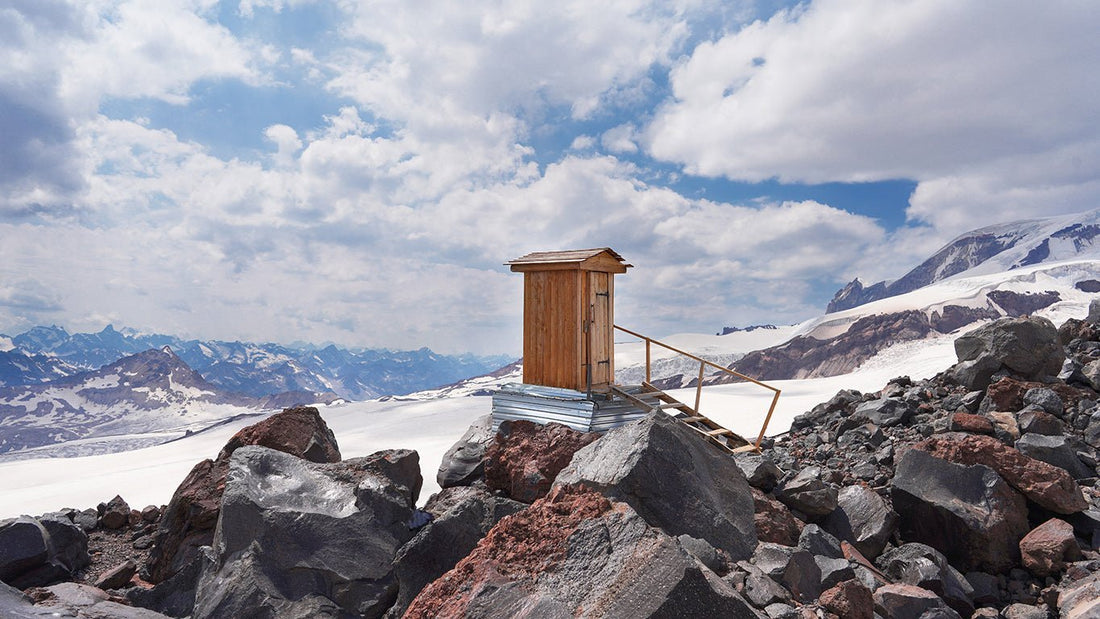
How to pee in the mountains: a guide for women
Share
It’s an unavoidable fact that we all have to pee several times a day. Unfortunately, female anatomy makes this much more tricky for us than our male counterparts, particularly if you’re wearing a climbing harness! If you’re on a glacier or technical terrain, detaching from the rope for a bathroom break may not be possible, let alone safe. And if you’re on a big mountain you might be camping or bivvying somewhere quite exposed, limiting your options. We’d hate for this to put you off having awesome adventures in the mountains, so we’ve put together this handy guide to help.
First off though, a sidebar on hydration. It is super important to maintain hydration for both physical and mental performance in the mountains. As a woman you’re more likely to develop urinary tract infections such as cystitis if you don’t drink enough. If you’re at altitude it’s even more important, as dehydration causes your blood to thicken further which can cause life-threatening conditions like AMS, HAPE and HACE (Acute Mountain Sickness, High Altitude Pulmonary Oedema and High Altitude Cerebral Oedema).
Here are some quick tips to help manage your hydration on big mountain days:
- Pre-hydrate - drink as much as you can the night before a big day, so you at least start off well hydrated.
- Skip the diuretics like caffeine in the morning - if you can bear to!
- Go before you start for the day - it’s so easy to feel rushed with an Alpine start, but try and make the time. You’ll be glad you did!
- Make rehydrating a priority at the end of the day, especially if you are on the move again the next day.
If you’re limiting your fluid intake because you’re worried about needing to pee, you’re not alone but there is plenty you can do to help manage the issue. Here are some things to think about:
- Have a plan - think about how and where you might go if you need to, and if you can make it easier (e.g. before you put a harness on).
- Have a back up in case you get caught short - consider wearing a sanitary pad or incontinence underwear.
- Get to know your gear - finding the release point for your leg loops on the back of your climbing harness is easier with warm hands!
- Ask your team mates to turn and face the other way while you go (and you can do the same for them). There’s usually a good view to admire instead!
But how do you actually go for a pee without removing your climbing harness? Well, there are several different options - some more obvious than others, and some requiring the right clothing set up. Here’s a run down of the solutions we’ve used, their pros and cons, and other factors you might want to consider.
The squat and go
The simplest approach, which doesn’t require anything special, is tounclip your harness leg loops at the back and pull down your trousers and underwear as you would normally, then squat and go. This has the disadvantage of exposing the most amount of flesh, and gets tricky if you have multiple layers that need undoing at the waist underneath your harness. A top tip is finding something you can lean your back against, to take the strain off your thighs and provide a bit of modesty and protection from the elements – and don’t forget to tuck all your layers back in afterwards!
The stand up trick
Alternatively, you can buy a female urinary device (basically a funnel) that in theory allows you to pee standing up, just like the guys (or at least, that’s the intention). There are a few different styles on the market, including Shewee and GoGirl. The idea is you undo your fly zip (which needs to be long enough) and slot the funnel between you and your underwear, which collects the urine as you go and directs it out the other end. You can get extension tubes which help if you’re wearing a lot of layers, and you’ll have to make sure your harness belay loop is out of the way too.
Some women love the freedom these devices give, but they don’t work for everyone. It can be tricky to get the position and hold the device in place with the right amount of pressure to prevent leaks and/or overflow. Some women have reported finding it hard to override the natural tendency to not go when you’re standing up! It’s definitely worth having a practise at home in a ‘low consequence’ environment (like the bath or shower) to learn what works and what doesn’t, especially when it comes to compatibility with different clothing layers. Be warned, if you get it wrong in anger you’ll end up with pee running down your leg and into your socks and boots. Bad times, especially if you’re on a multi-day trip!
Zips to the rescue
If that all sounds like more trouble than it’s worth, then there are a couple of ways that your clothing can help with access when you need to go. One is a front-to-back zip through the crotch area, which can be found on some insulated suits/overtrousers and more regular trousers/pants. The idea being you squat, undo the zip, pull your underwear to the side and go as normal. You won’t find this set up on tight fitting baselayers or leggings for good reason: because ouch, chafing.
The main issue with this method is that it doesn’t work if you’re wearing boy short/boxers or any kind of baselayer legging underneath the layer with the zip. So it’s ok for not-too-cold conditions, and works quite well if you’re wearing a harness.
The second option is a rainbow-shaped zip across the backside which drops the seat of the trousers/pants, again used in a squatting position. This is sometimes called a drop-seat or the delightful ‘crap flap’ since that’s when guys would need it. This has the advantage of allowing you to reach and pull down other layers underneath (provided they have a stretchy waistband), so boy shorts, boxers, or leggings shouldn’t be a problem. Even better if the layers underneath also have a matching drop seat zip. The downside of this method is you’re exposing quite a lot of flesh which can get cold, although if modesty is a concern you’re actually fully covered from the front. Don’t forget to pull the flap forwards out of the way to make sure you don’t pee on it! You can do all this with your harness still on, all you have to do is release the leg loop clip found at the centre back of the harness before you start, and don’t forget to do it up again afterwards. Here's a handy visual to help explain:

On some outer layer waterproof or insulated trousers, you may have full length side zips which allow you to undo from the top of the waistband downwards. It’s slightly harder to manage as it means getting under the waistband of your harness. If you’re not wearing a harness the front of the trousers will also want to come down unless you have braces attached. Otherwise this has the same pros/cons as the rainbow zip option.
In camp: the pee bottle
If you’re on technical terrain or camping in extreme cold you may not want (or be able to) get out of the tent to pee - at night or during the day.
The easiest tactic here is to employ the use of a pee bottle. A wide mouthed non-metal bottle (e.g. Nalgene) serves this purpose really well. A one litre (32 oz) capacity is advisable, even though you may not fill it, you definitely don’t want to be trying to stop mid flow! It’s surprisingly easy to position the mouth of the bottle between your legs from a kneeling position. With a bit of practise, you can even do it inside your sleeping bag, but if you’re worried about spillages try unzipping and using the bag as a ‘modesty blanket’ so if you get it wrong only your sleeping mat will suffer! Have some tissues/a cloth handy for wiping up in any case.
If you want a bit more privacy (or struggle with stage fright), it is possible to employ the same tactic in the safety of the tent porch - depending on how big it is and how tall you are. This has the added benefit of allowing you to empty the bottle straight away (just be careful where you do this, if you have food or gear lying around!). A word of warning, if you don’t empty your pee bottle and it’s cold enough overnight it will freeze; which means you end up having to carry your frozen urine around with you which is a massive waste of energy, and you might not be able to use the bottle again. If you do the lid up tight enough you can keep it in your sleeping bag overnight, which will help prevent it freezing and might even keep your feet warm. Joking aside though, it is better-out-than-in as storing urine actually requires your body to keep it at body temperature which wastes energy that could otherwise be used to keep other parts of you warmer. This is why you should always bother getting up to pee on a cold night – trust us, you will feel warmer when you are back in your sleeping bag and not trying to keep 300ml of waste water warm in your bladder!
Some top tips for your pee bottle: use something obviously different to your drinking water bottle. No one wants to mix those up… which is easy to do in the dark! Ideally it should feel different, so you can tell it apart even in low light. For example, using a bit of cord or tape somewhere on the bottle. Stick a label on it (e.g. ‘don’t drink!’) to make sure your tent mate doesn’t pick it up to put your morning brew in it. Grim. You can get glow in the dark bottles which have some pros (easy to find) but also some cons - you might not want it glowing while you use it!
Hopefully these practical tips will make peeing on a mountain or glacier a little easier. So you can spend more time dreaming about big mountain adventures and a little less time worrying about bathroom breaks.
Bet you need to go now, don’t you? I know I do.
